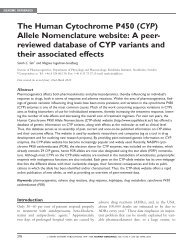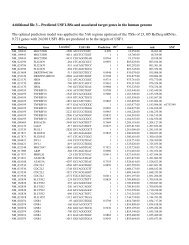Neurofibromatosis type 1-associated tumours ... - Human Genomics
Neurofibromatosis type 1-associated tumours ... - Human Genomics
Neurofibromatosis type 1-associated tumours ... - Human Genomics
Create successful ePaper yourself
Turn your PDF publications into a flip-book with our unique Google optimized e-Paper software.
REVIEW<br />
Laycock-van Spyk et al.<br />
Table 3: The spectrum and percentile distribution of somatic NF1 micro-lesions reported in different NF1-<strong>associated</strong> <strong>tumours</strong><br />
Tumour <strong>type</strong><br />
Mutation <strong>type</strong><br />
Deletion Insertion Indel Nonsense Splice site Missense Truncating Total<br />
Dermal neurofibroma 82 (39%) 15 (7%) 2 (1%) 59 (28%) 32 (15%) 21 (10%) 158 (75%) 211<br />
Plexiform<br />
neurofibroma<br />
6 (33%) 1 (6%) – 7 (39%) 2 (11%) 2 (11%) 14 (78%) 18<br />
Spinal neurofibroma – – – – 2 (66%) 1 (33%) 0 3<br />
MPNST 7 (70%) 1 (10%) 1 (10%) 1 (10%) – – 10 (100%) 10<br />
GIST/gastric carcinoid 1 (20%) – – 3 (60%) 1 (20%) – 4 (80%) 5<br />
JMML * * * * 1 (100%) * * 1 (100%) 1<br />
Glomus tumour 2 (33%) 1 (17%) – 1 (17%) 2 (33%) – 4 (67%) 6<br />
Overall 98 (39%) 18 (7%) 3 (1%) 72 (28%) 39 (15%) 24 (9%) 191 (75%) 254<br />
* Compound heterozygosity of NF1 mutations in several JMML <strong>tumours</strong> cases meant it was not possible to distinguish between <strong>associated</strong> germline and somatic NF1 mutations.<br />
alterations found in cutaneous neurofibromas at frequencies<br />
of 28 per cent (59/211), 15 per cent (32/<br />
211) and 10 per cent (21/211), respectively<br />
(Table 3). Table 3 does, however, serve to highlight<br />
the high proportion of truncating mutations (191/<br />
254; ≏75 per cent) involved in the somatic inactivation<br />
of the NF1 gene in all tumour <strong>type</strong>s,<br />
especially cutaneous neurofibromas.<br />
An additional comparison between the frequency<br />
distributions of somatic microlesions and<br />
LOH is made in Table 1. There appears to be a<br />
marked difference between cutaneous neurofibromas,<br />
PNFs and MPNSTs, with 40 per cent, 79 per<br />
cent and 85 per cent, respectively, of somatic<br />
mutation events represented by LOH. This may be<br />
explained in part by the extent of the molecular<br />
rearrangements in each tumour <strong>type</strong>; MPNSTs, for<br />
example, would be predicted to exhibit a greater<br />
extent of genetic aberration than a benign dermal<br />
neurofibroma. The <strong>type</strong>s of analyses performed,<br />
however, will have a direct influence on such conclusions,<br />
in that either microlesions or LOH may<br />
not be screened for in some studies.<br />
In summary, the more severe MPNSTs show a<br />
greater degree of genetic abnormality than other<br />
tumour <strong>type</strong>s, with LOH constituting a much more<br />
frequent event in these <strong>tumours</strong>. Further comparison<br />
within and between the rarer tumour <strong>type</strong>s would<br />
not be valid, however, owing to the relative paucity<br />
of mutation data currently available for analysis.<br />
Mutational mechanisms underlying<br />
the known somatic NF1 gene lesions<br />
Somatic inactivation of the NF1 gene may result<br />
from different mutational mechanisms and may<br />
involve intragenic mutations, LOH and epigenetic<br />
modification of the promoter region. Among the<br />
254 somatic NF1 mutations listed in Table S2, 72<br />
nonsense mutations were found, of which 36<br />
involved mutations in just 15 codons in different<br />
<strong>tumours</strong> (codons 192, 304, 426, 440, 816, 1241,<br />
1306, 1362, 1513, 1569, 1604, 1748, 1939, 1976<br />
and 2429), with many previously reported in different<br />
<strong>tumours</strong> or different studies. Ten of these 15<br />
different recurrent nonsense mutations involve C .<br />
Tor G. A transitions within CpG dinucleotides<br />
and are compatible with the endogenous mutational<br />
mechanism of methylation-mediated deamination of<br />
5-methylcytosine (5mC). Of these 72 nonsense<br />
mutations, 28 have also been reported as germline<br />
mutations in NF1 patients (<strong>Human</strong> Gene Mutation<br />
Database [HGMD]), 81 indicating that the same mutational<br />
mechanism is operating in both the soma and<br />
630 # HENRY STEWART PUBLICATIONS 1479–7364. HUMAN GENOMICS. VOL 5. NO 6. 623–690 OCTOBER 2011





